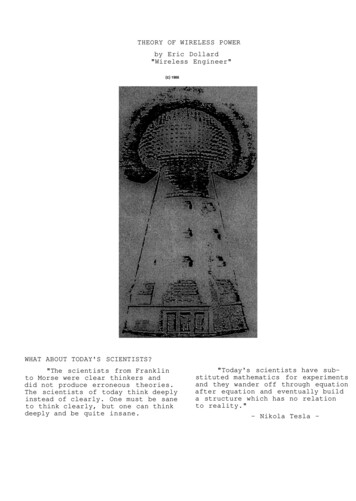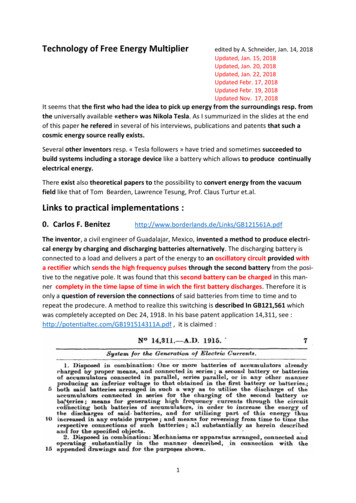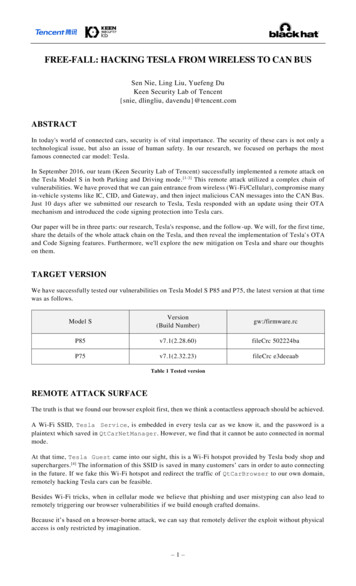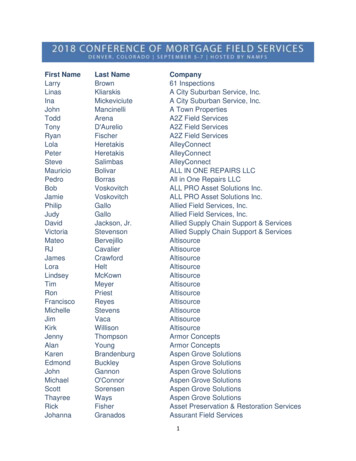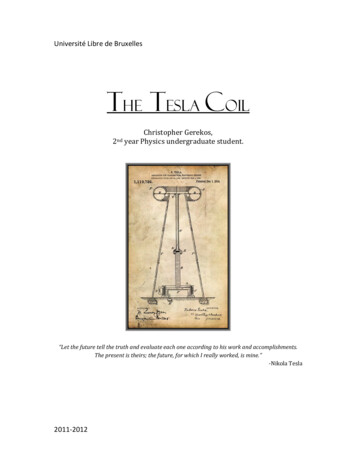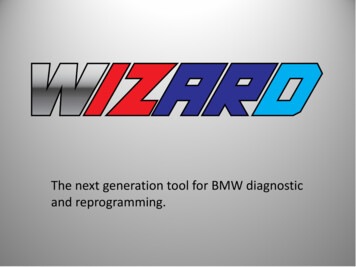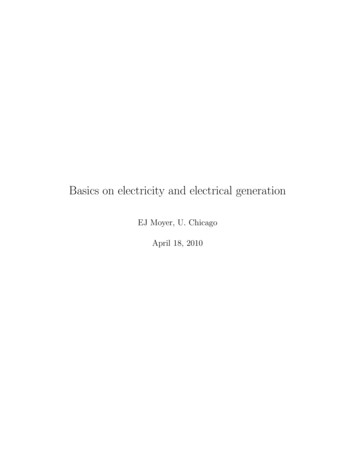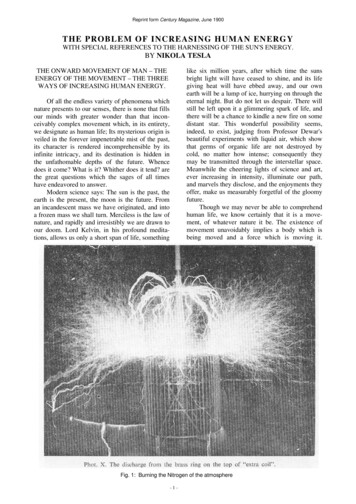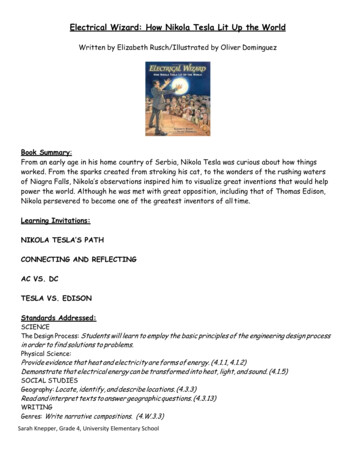
Transcription
Electrical Wizard: How Nikola Tesla Lit Up the WorldWritten by Elizabeth Rusch/Illustrated by Oliver DominguezBook Summary:From an early age in his home country of Serbia, Nikola Tesla was curious about how thingsworked. From the sparks created from stroking his cat, to the wonders of the rushing watersof Niagra Falls, Nikola’s observations inspired him to visualize great inventions that would helppower the world. Although he was met with great opposition, including that of Thomas Edison,Nikola persevered to become one of the greatest inventors of all time.Learning Invitations:NIKOLA TESLA’S PATHCONNECTING AND REFLECTINGAC VS. DCTESLA VS. EDISONStandards Addressed:SCIENCEThe Design Process: Students will learn to employ the basic principles of the engineering design processin order to find solutions to problems.Physical Science:Provide evidence that heat and electricity are forms of energy. (4.1.1, 4.1.2)Demonstrate that electrical energy can be transformed into heat, light, and sound. (4.1.5)SOCIAL STUDIESGeography: Locate, identify, and describe locations. (4.3.3)Read and interpret texts to answer geographic questions. (4.3.13)WRITINGGenres: Write narrative compositions. (4.W.3.3)Sarah Knepper, Grade 4, University Elementary School
Items included on the following pages:1. Copy of Student Booklet2. Resources to cut out/assemble invitation stations(*Note, I am including a link to each video in case the QR codes do not work.Some student iPads had issues with them)3. Photos of finished product and students workingSarah Knepper, Grade 4, University Elementary School
NameElectrical Wizard:How Nikola Tesla Lit Up the World(Student Booklet)Invitations to Explore(check off when finished)NIKOLA TESLA’S PATH (p. 2-3)CONNECTING AND REFLECTING (p. 4-5)AC vs. DC (p.6)TESLA VS. EDISON (p. 7-8)Sarah Knepper, Grade 4, University Elementary School
1Sarah Knepper, Grade 4, University Elementary School
NIKOLA TESLA’S PATH1. Nikola’s hometown is Smiljab, in what is now Croatia. On the map above,draw a star on the approximate location of Smiljab. (Use the map onthe display for help.)2. What are your thoughts about the video? Did anything surprise you aboutNikola Tesla’s hometown?3. In 1880, Nikola Tesla moved to Budapest Hungary. Find Budapest on themap above and circle it. Next, draw a dotted line from the star of Smiljabto Budapest to show his path.4. In 1882, Nikola Tesla moved to Paris, France. Find Paris on the map aboveand circle it. Next, draw a dotted line from the Budapest to Paris toshow his path.Sarah Knepper, Grade 4, University Elementary School
2Sarah Knepper, Grade 4, University Elementary School
5. In 1884, Nikola Tesla moved to the United States to live in New YorkCity. Find New York City and Paris on the map below and circle bothcities. Draw a dotted line to show Tesla’s path from Paris to New YorkCity.6. Use the display to locate the populations of each place Nikola Teslalived. Fill in the table showing the order of population from greatest toleast.PlacePopulation (greatest to least)7. Study all the photos and information on the display about Smiljan,Budapest, Paris, and New York City.Which one of these places would you like to visit the most?Explain why you chose this place and not the others.Sarah Knepper, Grade 4, University Elementary School
3Sarah Knepper, Grade 4, University Elementary School
CONNECTING AND REFLECTING1. Think about the story you heard about Nikola Tesla. What learnerprofile comes to mind when you think about him? Choose one andexplain why you chose it using evidence from the text.2. Now look at the list of attitudes. What attitude do you thinkNikola Tesla displayed? Explain why using evidence from the text.3. In your opinion, what effect did Nikola Tesla’s ideas andinventions have on the world? What would life have been likewithout him?Sarah Knepper, Grade 4, University Elementary School
4Sarah Knepper, Grade 4, University Elementary School
4. There were several things from Nikola Tesla’s childhood thatsparked his interest in science and inventions. The display shows acouple.Is there anything that you wonder (or have wondered) about?What are you interested in finding out more about or what problemare you interested in solving?Use the space below to include a sketch if you would like.Sarah Knepper, Grade 4, University Elementary School
5Sarah Knepper, Grade 4, University Elementary School
AC vs. DC1. Watch the video about the difference between AlternatingCurrent and Direct Current.2. Complete the double bubble below to outline the similaritiesand differences between Alternating Current and DirectCurrent.Sarah Knepper, Grade 4, University Elementary School
6Sarah Knepper, Grade 4, University Elementary School
TESLA VS. EDISONNikola Tesla and Thomas Edison had their differences. Every storyhas two sides. The book gave you Nikola Tesla’s perspective. Now,try to imagine the story from Thomas Edison’s perspective.1. Read the passage “Tesla vs. Edison: The Rivalry” from the backof the book.2. Think about how a conversation between Nikola Tesla andThomas Edison might have gone. Choose a setting (time andplace) and create dialogue between the two.Sarah Knepper, Grade 4, University Elementary School
7Sarah Knepper, Grade 4, University Elementary School
3. Write a short story from the perspective of Thomas Edison.Pretend you are trying to convince Nikola Tesla that DirectCurrent is the best choice. Use evidence and details you havelearned about Nikola Tesla.Sarah Knepper, Grade 4, University Elementary School
8Sarah Knepper, Grade 4, University Elementary School
NIKOLA TESLA’S PATHJuly 10, 1856Nikola Tesla, a Serbian, was born in what is now Smiljan, Croatia. He was one of fivechildren. His family was SerbiHis mother, Djuka Mandic, invented small householdappliances, which sparked Nikola’s interest in science.Watch this video to get a glimpse of his hometown of Smiljan. (Scan the QR Code and besure to set the YouTube video to full screen.) It shows the Nikola Tesla Memorial Centre.You will answer questions 1 and 2 in your booklet when you are finished watching.https://youtu.be/8YWDbXFEDT4Sarah Knepper, Grade 4, University Elementary School
Sarah Knepper, Grade 4, University Elementary School
1880After studying engineering at Graz Technical University (now in Austria) and the Universityof Prague (now in the Czech Republic) Tesla moved to Budapest (in present day Hungary) in1880. He worked for the Austria-Hungary’s phone system in Budapest called the CentralTelephone Exchange.Sarah Knepper, Grade 4, University Elementary School
Sarah Knepper, Grade 4, University Elementary School
Sarah Knepper, Grade 4, University Elementary School
1882Nikola Tesla moved to Paris, France. He worked for the Continental Edison Company.Sarah Knepper, Grade 4, University Elementary School
Sarah Knepper, Grade 4, University Elementary School
1884Nikola Tesla moved to the United States to live in New York City and work for ThomasEdison. This only lasted for about one year, as the two encountered conflicts in ideas, andsome say, personality. Tesla remained in New York until he died on January 7, 1943, at theage of 86.Sarah Knepper, Grade 4, University Elementary School
Sarah Knepper, Grade 4, University Elementary School
CONNECTING ANDREFLECTINGSarah Knepper, Grade 4, University Elementary School
AC vs. DCWhat is the differencebetween Alternating CurrentandDirect Current?Sarah Knepper, Grade 4, University Elementary School
Watch this video about the differencebetweenDirect Current and ah Knepper, Grade 4, University Elementary School
Sarah Knepper, Grade 4, University Elementary School
TESLA VS. EDISONSarah Knepper, Grade 4, University Elementary School
Sarah Knepper, Grade 4, University Elementary School
Niagra Falls“[A young inventor’s] first endeavors are purely instinctive, promptings of an imaginationvivid and undisciplined. As we grow older reason asserts itself and we become more andmore systematic and designing. But those early impulses, though not immediatelyproductive, are of the greatest moment and may shape our very destinies.” Nikola TeslaSarah Knepper, Grade 4, University Elementary School
Sarah Knepper, Grade 4, University Elementary School
c;;:, .------· Sarah Knepper, Grade 4, University Elementary School
Sarah Knepper, Grade 4, University Elementary School
Sarah Knepper, Grade 4, University Elementary School
Electrical Wizard: How Nikola Tesla Lit Up the World Written by Elizabeth Rusch/Illustrated by Oliver Dominguez Book Summary: From an early age in his home country of Serbia, Nikola Tesla was curious about how things worked. From the sparks created fr

